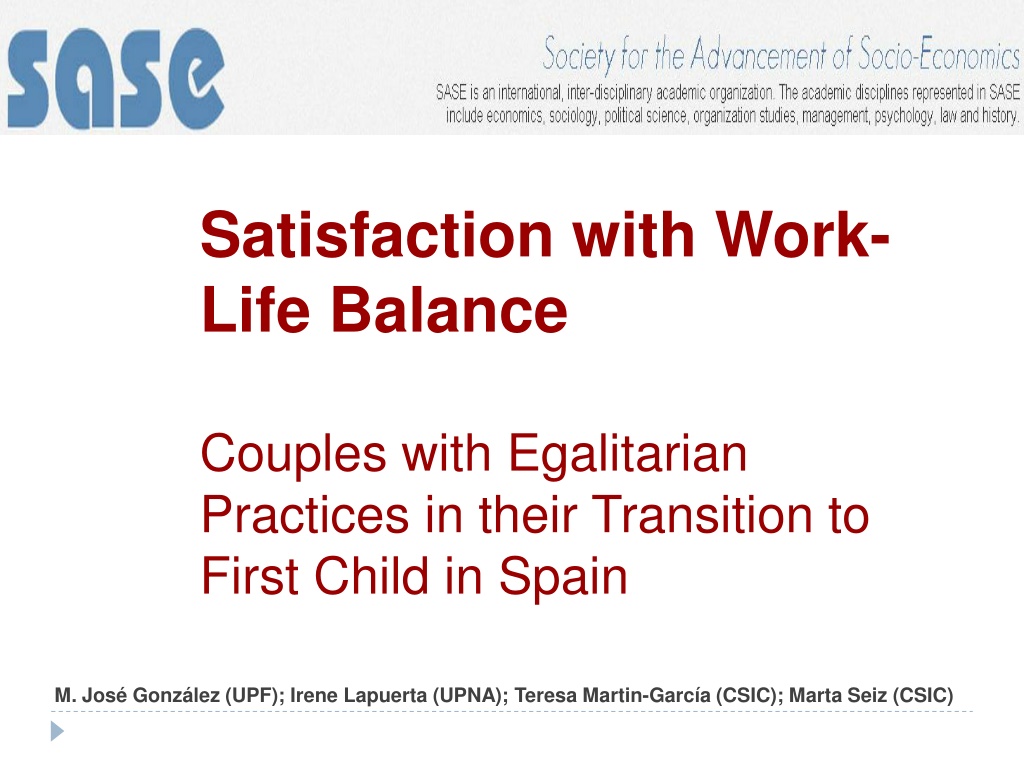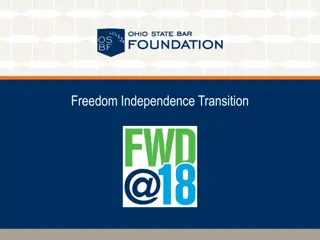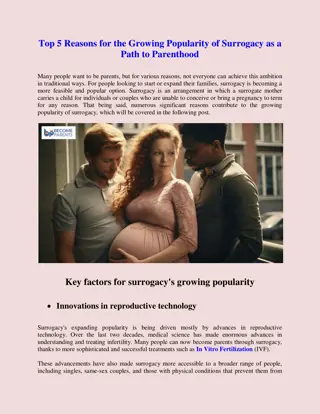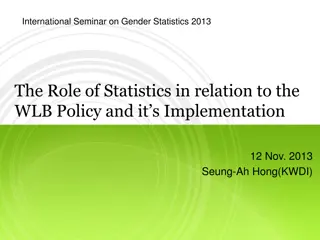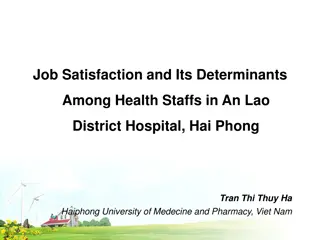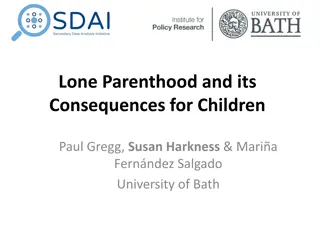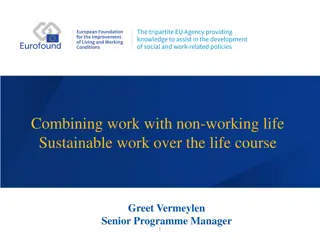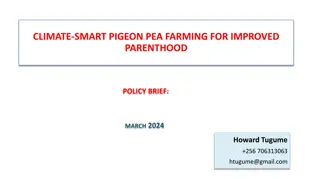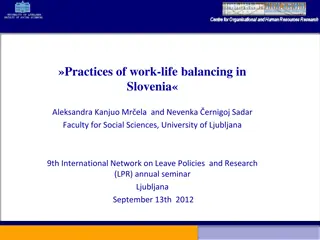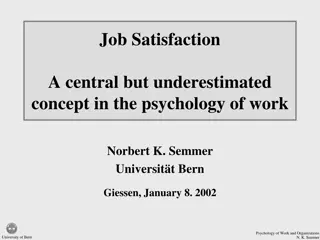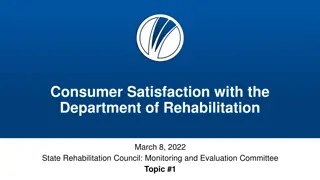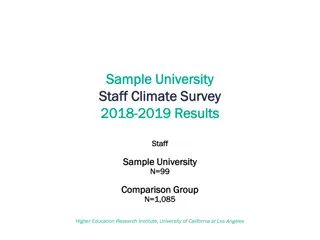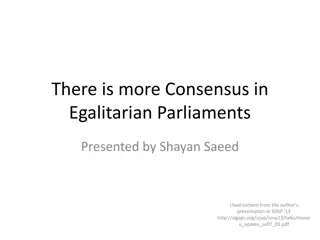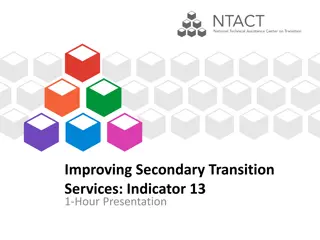Satisfaction with Work-Life Balance: Egalitarian Practices in Transition to Parenthood
This study explores the impact of gender equality and work-life balance on couples transitioning to parenthood in Spain. It examines how variations in paternal involvement, violated expectations, and reconciliation strategies affect satisfaction with work-life balance. The findings highlight the importance of positive paternal involvement and realistic expectations in promoting a healthy transition to parenthood.
- Work-life balance
- Egalitarian practices
- Transition to parenthood
- Gender equality
- Paternal involvement
Download Presentation

Please find below an Image/Link to download the presentation.
The content on the website is provided AS IS for your information and personal use only. It may not be sold, licensed, or shared on other websites without obtaining consent from the author. Download presentation by click this link. If you encounter any issues during the download, it is possible that the publisher has removed the file from their server.
E N D
Presentation Transcript
Satisfaction with Work- Life Balance Couples with Egalitarian Practices in their Transition to First Child in Spain M. Jos Gonz lez (UPF); Irene Lapuerta (UPNA); Teresa Martin-Garc a (CSIC); Marta Seiz (CSIC)
2. Background: Work-Life Balance, Gender Equality and the Transition to Parenthood The work-family literature is dominated by a conflict perspective (scarcity hypothesis): it is assumed that individuals who participate in multiple roles (e.g. those related to work and family) inevitably experience conflict and stress that detract from their quality of life (Marks, 1977; Sieber,1974) . Other authors emphasize that the advantages of pursuing multiple roles are likely to outweigh the disadvantages (an expansionist hypothesis) (Barnett & Baruch,1985;Marks,1977;Sieber,1974). Researchers have also posited that sex-role attitudes influence the experience of multiple roles: individuals with traditional attitudes are more likely to experience strains, whereas individuals with egalitarian attitudes are more likely to experience role gratification (Barnett & Baruch, 1985; Gerson, 1985; Marshall & Barnett, 1991). E.g.: within a two-earner family, the man's attitude towards his partner's employment may also be important,at least for his own well-being (Kessler & McRae,1982).
(a) New insights in the discussion: Variations in paternal involvement in the transition to fatherhood (Habib, 2012) as a means of understanding the emergence of a new identity status, that is, becoming a father (identity theory). Three dimensions of paternal involvement (Lamb, Pleck, Charnov, and Levine (1985, 1987): (1) engagement (e.g. time in caregiving and play); (2) accessibility (availability time); (3) and responsibility (e.g. making decisions for the child). Implicit in these dimensions is the notion of positive paternal involvement, which is likely to promote a healthy development of the child.
(b) New insights in the discussion: Literature on violated expectations, which are found to be a stronger predictor of depression and relationship satisfaction than the reported division of labour (Biehle & Mickelson,2012). Violated expectations may lead to less satisfaction with the transition to parenthood (e.g., Belsky, 1985; Khazan, McHale, & Decourcey, 2008): researchers have argued that the actual division of childcare is less important than whether expectations. the division meets one s
3. What drives Satisfaction with Work- Life Balance? I.Satisfaction is related to the consonance between expectations (the couples ideal organization) and reality (the couples actual time allocation to care and employment) (Violated expectations) -> Longitudinal & relational mechanism. II. Satisfaction with the reconciliation strategy is related to the ability of fathers- to-be to anticipate changes with the arrival of the child & develop a positive paternal involvement (Paternal involvement) -> Longitudinal & relational mechanism. III. Satisfactory reconciliation strategies (i.e. a high level of satisfaction within the couple) are largely determined by a favourable institutional context such as a friendly work environment, accessibility to services, time or other resources (Institutional context). -> Cross-sectional & relational mechanism.
4. The Spanish case study in context Figure 1: Activity rates by gender and age groups (30-34 & 35-39) in Spain, 1998-2014. 100.0 90.0 80.0 Males 30-34 Males 35-39 Females 30-34 Females 35-39 70.0 60.0 50.0 2009Q2 1998Q2 1999Q2 2000Q2 2001Q2 2002Q2 2003Q2 2004Q2 2005Q2 2006Q2 2007Q2 2008Q2 2010Q2 2011Q2 2012Q2 2013Q2 2014Q1 Source: Labour Force Survey.
Figure 1. Type of couples in Spain, 1999-2014 80 70 60 50 % 40 30 20 10 0 1999 2000 2001 Both without paid work Female breadwinner 2002 2003 2004 2005 2006 2007 2008 2009 Male breadwinner Dual-earner couples 2010 2011 2012 2013 2014 Field work 2011-2013 Source: Labour Force Survey.
Figure 2. Womens mean age at first child & Total Fertility Rates, 1999-2013 31 30,4 2,40 30,3 30,1 30 2,20 29,8 29,6 29,5 29,3 29,3 29,3 29,3 29,2 29,2 29,1 29,1 29 2,00 29,0 Mothers' age TFR 1,80 28 1,60 27 1,40 26 1,20 25 1,00 1999 2000 2001 2002 2003 2004 2005 2006 2007 2008 2009 2010 2011 2012 2013 Mean age at first child Period Fertility Rates Source: Labour Force Survey.
5. Method Longitudinal Qualitative Research (QLR) Childbearing (1 year and a half later): 2NDWAVE Birth Pregnancy (Dual- earners first-time parents): 1STWAVE
6. Sample 31 Couples expecting their first child (sub-sample from 68 couples from international research project TransParent). Bi-active couples (both partners in the labour market) Egalitarian practices: she does not do more than 60% of the housework and he does at least 40% (self-declared) excluding domestic help. Longitudinal sample: interviewed in 2011 (at the time of the pregnancy) and again in 2013 (child at pre-school age)
Table 1. Characteristics of the sample: couples monthly income & relative resources, 2011 (1st wave) Homogamy Hypergamy Hypogamy Couples monthly income: 1,500-2,499 2,500-3,999 4,000 or more Total Total 1 3 1 5 3 5 4 5 6 3 9 14 8 31 12 14
High income couple (hypogamy), she university studies; he secondary studies; both top managers (he in small company; she in a large company) -> unsatisfied mother (violated expectations) 1stwave: TERESA: you know, I wish he could do the same [caring] but, uh, uh, looking for the time, finding the time to be together the three of us... I guess he will, but it will definitely be harder for him than for me. 2ndwave: TERESA: I m really fed up, he does something at home [ ] but I see that all the caring is on my shoulders, and I was talking to a friend and we realized that it has nothing to do with wages or your position at work or whether men do more hours at work, because we both work the same and the responsibility basically lies on me and if we talk about wages, I have a higher wage and still
Figure 1: Couples Satisfaction with Work-Life Balance Satisfaction: Equal share of care tasks [15 couples] Unequal, but women satisfied although they assumed the great bulk of care tasks... Reconciling Model: Both satisfied Unfavourable circumstances that hinder equitable sharing [2 couples] Different conception of motherhood/fatherhood; justified by different work demands in the couple [7 couples] Unequal, fathers lack of accessibility and responsibility[4 couples] Unequal, women unsatisfied with themselves (guilty, feeling absence)[3 couples] He satisfied; She unsatisfied
10. Discussion Both fulfilling expectations & positive paternal involvement enhances satisfaction with the reconciling model in the couple (institutional context not enough to explain satisfaction/dissatisfaction!). Why so many fist-time fathers satisfied & so many mothers unsatisfied? (egalitarian in practices in wave 1; unequal in wave 2); major differences in the ideals about motherhood/ fatherhood . Mothers need to fulfil the three dimensions (engagement; accessibility and responsibility) = fathers are satisfied if they are engaged or accessible (less demanding parenthood)
Website Spanish Project: http://transparent.upf.edu/ Website International Project: http://www.transparent-project.com/
